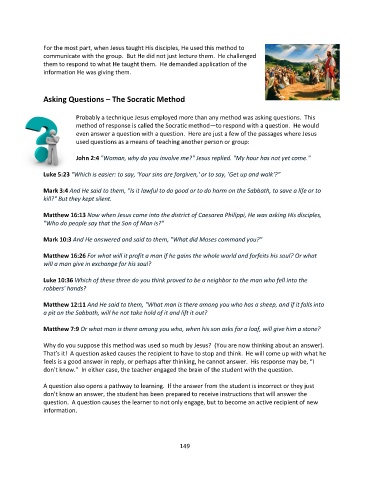Page 150 - Discipleship Ministries Student E-Book
P. 150
For the most part, when Jesus taught His disciples, He used this method to
communicate with the group. But He did not just lecture them. He challenged
them to respond to what He taught them. He demanded application of the
information He was giving them.
Asking Questions – The Socratic Method
Probably a technique Jesus employed more than any method was asking questions. This
method of response is called the Socratic method—to respond with a question. He would
even answer a question with a question. Here are just a few of the passages where Jesus
used questions as a means of teaching another person or group:
John 2:4 "Woman, why do you involve me?" Jesus replied. "My hour has not yet come."
Luke 5:23 “Which is easier: to say, 'Your sins are forgiven,' or to say, 'Get up and walk'?”
Mark 3:4 And He said to them, "Is it lawful to do good or to do harm on the Sabbath, to save a life or to
kill?" But they kept silent.
Matthew 16:13 Now when Jesus came into the district of Caesarea Philippi, He was asking His disciples,
"Who do people say that the Son of Man is?"
Mark 10:3 And He answered and said to them, "What did Moses command you?"
Matthew 16:26 For what will it profit a man if he gains the whole world and forfeits his soul? Or what
will a man give in exchange for his soul?
Luke 10:36 Which of these three do you think proved to be a neighbor to the man who fell into the
robbers' hands?
Matthew 12:11 And He said to them, "What man is there among you who has a sheep, and if it falls into
a pit on the Sabbath, will he not take hold of it and lift it out?
Matthew 7:9 Or what man is there among you who, when his son asks for a loaf, will give him a stone?
Why do you suppose this method was used so much by Jesus? (You are now thinking about an answer).
That’s it! A question asked causes the recipient to have to stop and think. He will come up with what he
feels is a good answer in reply, or perhaps after thinking, he cannot answer. His response may be, “I
don’t know.” In either case, the teacher engaged the brain of the student with the question.
A question also opens a pathway to learning. If the answer from the student is incorrect or they just
don’t know an answer, the student has been prepared to receive instructions that will answer the
question. A question causes the learner to not only engage, but to become an active recipient of new
information.
149

